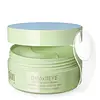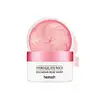What's inside
What's inside
 Key Ingredients
Key Ingredients

 Benefits
Benefits

 Concerns
Concerns

 Ingredients Side-by-side
Ingredients Side-by-side

Water
Skin ConditioningGlycerin
HumectantCalcium Chloride
AstringentXanthan Gum
EmulsifyingCeratonia Siliqua Gum
EmollientNiacinamide
SmoothingButyrospermum Parkii Butter
Skin ConditioningChondrus Crispus Powder
AbrasiveAllantoin
Skin ConditioningArginine
MaskingGold
Cosmetic ColorantCocos Nucifera Fruit Extract
EmollientPinus Sylvestris Leaf Extract
TonicCucumis Sativus Fruit Extract
EmollientRubus Idaeus Fruit Extract
AstringentRubus Coreanus Fruit Extract
Skin ConditioningVaccinium Angustifolium Fruit Extract
Skin ProtectingRibes Nigrum Leaf Extract
PerfumingEuterpe Oleracea Fruit Extract
Camellia Sinensis Leaf Extract
AntimicrobialChamomilla Recutita Flower Extract
MaskingCamellia Japonica Flower Extract
EmollientArnica Montana Flower Extract
MaskingAloe Barbadensis Leaf Extract
EmollientSodium Hyaluronate
HumectantCaffeine
Skin ConditioningDipotassium Glycyrrhizate
Humectant1,2-Hexanediol
Skin ConditioningPentylene Glycol
Skin ConditioningHydroxyacetophenone
AntioxidantPolyglyceryl-10 Laurate
Skin ConditioningEthylhexylglycerin
Skin ConditioningCellulose Gum
Emulsion StabilisingSodium Phytate
Phenoxyethanol
PreservativeSynthetic Fluorphlogopite
CI 77891
Cosmetic ColorantCI 77288
Cosmetic ColorantWater, Glycerin, Calcium Chloride, Xanthan Gum, Ceratonia Siliqua Gum, Niacinamide, Butyrospermum Parkii Butter, Chondrus Crispus Powder, Allantoin, Arginine, Gold, Cocos Nucifera Fruit Extract, Pinus Sylvestris Leaf Extract, Cucumis Sativus Fruit Extract, Rubus Idaeus Fruit Extract, Rubus Coreanus Fruit Extract, Vaccinium Angustifolium Fruit Extract, Ribes Nigrum Leaf Extract, Euterpe Oleracea Fruit Extract, Camellia Sinensis Leaf Extract, Chamomilla Recutita Flower Extract, Camellia Japonica Flower Extract, Arnica Montana Flower Extract, Aloe Barbadensis Leaf Extract, Sodium Hyaluronate, Caffeine, Dipotassium Glycyrrhizate, 1,2-Hexanediol, Pentylene Glycol, Hydroxyacetophenone, Polyglyceryl-10 Laurate, Ethylhexylglycerin, Cellulose Gum, Sodium Phytate, Phenoxyethanol, Synthetic Fluorphlogopite, CI 77891, CI 77288
Water
Skin ConditioningGlycerin
HumectantNiacinamide
SmoothingChondrus Crispus
MaskingButylene Glycol
HumectantCocos Nucifera Fruit Extract
EmollientPinus Sylvestris Leaf Extract
TonicPropanediol
SolventPentylene Glycol
Skin ConditioningRosa Damascena Flower Water
MaskingNelumbo Nucifera Flower Extract
Skin ConditioningPortulaca Oleracea Extract
Skin ConditioningHamamelis Virginiana Extract
AntiseborrhoeicCentella Asiatica Extract
CleansingEthylhexylglycerin
Skin ConditioningSodium Hyaluronate
HumectantDipotassium Glycyrrhizate
HumectantPEG-60 Hydrogenated Castor Oil
EmulsifyingCeratonia Siliqua Gum
EmollientSucrose
HumectantPotassium Chloride
Cyamopsis Tetragonoloba Gum
Emulsion StabilisingCalcium Chloride
AstringentAllantoin
Skin ConditioningTripropylene Glycol
AntioxidantDipropylene Glycol
HumectantCellulose Gum
Emulsion StabilisingChondrus Crispus Powder
AbrasiveRicinus Communis Seed Oil
MaskingCalcium Aluminum Borosilicate
Tin Oxide
AbrasiveCI 75470
Cosmetic ColorantCalcium Lactate
AstringentAdenosine
Skin ConditioningSynthetic Fluorphlogopite
Titanium Dioxide
Cosmetic ColorantDisodium EDTA
Ethyl Hexanediol
Solvent1,2-Hexanediol
Skin ConditioningChlorphenesin
AntimicrobialArginine
MaskingParfum
MaskingWater, Glycerin, Niacinamide, Chondrus Crispus, Butylene Glycol, Cocos Nucifera Fruit Extract, Pinus Sylvestris Leaf Extract, Propanediol, Pentylene Glycol, Rosa Damascena Flower Water, Nelumbo Nucifera Flower Extract, Portulaca Oleracea Extract, Hamamelis Virginiana Extract, Centella Asiatica Extract, Ethylhexylglycerin, Sodium Hyaluronate, Dipotassium Glycyrrhizate, PEG-60 Hydrogenated Castor Oil, Ceratonia Siliqua Gum, Sucrose, Potassium Chloride, Cyamopsis Tetragonoloba Gum, Calcium Chloride, Allantoin, Tripropylene Glycol, Dipropylene Glycol, Cellulose Gum, Chondrus Crispus Powder, Ricinus Communis Seed Oil, Calcium Aluminum Borosilicate, Tin Oxide, CI 75470, Calcium Lactate, Adenosine, Synthetic Fluorphlogopite, Titanium Dioxide, Disodium EDTA, Ethyl Hexanediol, 1,2-Hexanediol, Chlorphenesin, Arginine, Parfum
 Reviews
Reviews

Ingredients Explained
These ingredients are found in both products.
Ingredients higher up in an ingredient list are typically present in a larger amount.
1,2-Hexanediol is a synthetic liquid and another multi-functional powerhouse.
It is a:
- Humectant, drawing moisture into the skin
- Emollient, helping to soften skin
- Solvent, dispersing and stabilizing formulas
- Preservative booster, enhancing the antimicrobial activity of other preservatives
Allantoin is a soothing ingredient known for its protective and moisturizingg properties. Because of this, it is often added to products with strong active ingredients.
Studies show higher concentrations of this ingredient can promote wound healing.
Though it can be derived from the comfrey plant, allantoin is produced synthetically for cosmetic products to ensure purity.
Learn more about AllantoinArginine is an amino acid that is important for human development. Your body uses is it to produce hair keratin and skin collagen.
As a cosmetic ingredient, Arginine has antioxidant properties and can also help repair damaged skin. This ingredient is derived either synthetically or from animals.
Arginine isn't fungal acne safe when used in the presence of other lipids (fats, fatty acids, oils, esters, etc). Oils and fats occur naturally within the skin, so take caution when using Arginine if you're prone to fungal acne.
Learn more about ArginineCalcium chloride is a white, odorless, crystalline solid. It is an astringent and can be used to change the viscosity of products.
This ingredient is highly soluble in water, acetic acid, and ethanol.
There are many forms of this ingredient, including monohydrate, dihydrate, tetrahydrate, and hexahydrate.
Learn more about Calcium ChlorideCellulose Gum is a water-soluble polymer that comes from cellulose. It is used to change the texture of a product and to help stabilize emulsions.
As an emulsifier, cellulose gum specifically thicken the texture of water-based products.
This ingredient is considered hypoallergenic and non-toxic. Cellulose Gum can be found in cosmetics, food, and other household goods such as paper products.
Learn more about Cellulose GumCeratonia Siliqua Gum is extracted from the seeds of the carob tree. You might know this ingredient as Carob Gum or Locust Bean Gum. It is used to stabilize other ingredients and improve the texture of products.
Carob gum is made up of long-chain polysaccharides. This makes it a natural thickener.
Yes! This ingredient comes from the seeds of a tree. The name 'Locust Bean Gum' can be misleading.
Learn more about Ceratonia Siliqua GumChondrus Crispus Powder is an exfoliant.
Cocos Nucifera Fruit Extract comes from the meat of the coconut fruit. It is an emollient and skin conditioner with antioxidant properties.
Coconut fruit is naturally rich in amino acids, sugars, and nutrients including Vitamin C and small amounts of vitamin B. Malic acid can also be found in coconut fruit extract.
Dipotassium Glycyrrhizate comes from licorice root.
Extracts of licorice have demonstrated to have antibacterial, anti‐inflammatory, antiviral, antioxidant properties.
One component, glabridin, has extra potent antioxidant and soothing properties. It has also been found to block pigmentation from UVB rays in guinea pigs.
Licorice Root also contains a flavonoid. Flavonoids are a natural substance from in plants. Flavonoids also have antioxidant properties.
Another component, glycyrrhizin, has been found to have anti-inflammatory and antimicrobial benefits. This may make licorice root extract effective at treating acne. However, more research is needed to support this.
Liquiritin is one of the flavone compounds found in licorice. It has been found to help lighten skin by preventing tyrosinase from reacting with tyrosine. When the two react, protein is converted to melanin. Melanin is the substance in your body that gives your features pigmentation.
Licorice root is native to Southern Europe and Asia. It has been used in traditional Chinese medicine to help with respiratory issues.
Learn more about Dipotassium GlycyrrhizateEthylhexylglycerin (we can't pronounce this either) is commonly used as a preservative and skin softener. It is derived from glyceryl.
You might see Ethylhexylglycerin often paired with other preservatives such as phenoxyethanol. Ethylhexylglycerin has been found to increase the effectiveness of these other preservatives.
Glycerin is already naturally found in your skin. It helps moisturize and protect your skin.
A study from 2016 found glycerin to be more effective as a humectant than AHAs and hyaluronic acid.
As a humectant, it helps the skin stay hydrated by pulling moisture to your skin. The low molecular weight of glycerin allows it to pull moisture into the deeper layers of your skin.
Hydrated skin improves your skin barrier; Your skin barrier helps protect against irritants and bacteria.
Glycerin has also been found to have antimicrobial and antiviral properties. Due to these properties, glycerin is often used in wound and burn treatments.
In cosmetics, glycerin is usually derived from plants such as soybean or palm. However, it can also be sourced from animals, such as tallow or animal fat.
This ingredient is organic, colorless, odorless, and non-toxic.
Glycerin is the name for this ingredient in American English. British English uses Glycerol/Glycerine.
Learn more about GlycerinNiacinamide is a multitasking form of vitamin B3 that strengthens the skin barrier, reduces pores and dark spots, regulates oil, and improves signs of aging.
And the best part? It's gentle and well-tolerated by most skin types, including sensitive and reactive skin.
You might have heard of "niacin flush", or the reddening of skin that causes itchiness. Niacinamide has not been found to cause this.
In very rare cases, some individuals may not be able to tolerate niacinamide at all or experience an allergic reaction to it.
If you are experiencing flaking, irritation, and dryness with this ingredient, be sure to double check all your products as this ingredient can be found in all categories of skincare.
When incorporating niacinamide into your routine, look out for concentration amounts. Typically, 5% niacinamide provides benefits such as fading dark spots. However, if you have sensitive skin, it is better to begin with a smaller concentration.
When you apply niacinamide to your skin, your body converts it into nicotinamide adenine dinucleotide (NAD). NAD is an essential coenzyme that is already found in your cells as "fuel" and powers countless biological processes.
In your skin, NAD helps repair cell damage, produce new healthy cells, support collagen production, strengthen the skin barrier, and fight environmental stressors (like UV and pollution).
Our natural NAD levels start to decline with age, leading to slower skin repair, visible aging, and a weaker skin barrier. By providing your skin niacinamide, you're recharging your skin's NAD levels. This leads to stronger, healthier, and younger looking skin.
Another name for vitamin B3 is nicotinamide. This vitamin is water-soluble and our bodies don't store it. We obtain Vitamin B3 from either food or skincare. Meat, fish, wheat, yeast, and leafy greens contain vitamin B3.
The type of niacinamide used in skincare is synthetically created.
Learn more about NiacinamidePentylene glycol is typically used within a product to thicken it. It also adds a smooth, soft, and moisturizing feel to the product. It is naturally found in plants such as sugar beets.
The hydrophilic trait of Pentylene Glycol makes it a humectant. As a humectant, Pentylene Glycol helps draw moisture from the air to your skin. This can help keep your skin hydrated.
This property also makes Pentylene Glycol a great texture enhancer. It can also help thicken or stabilize a product.
Pentylene Glycol also acts as a mild preservative and helps to keep a product microbe-free.
Some people may experience mild eye and skin irritation from Pentylene Glycol. We always recommend speaking with a professional about using this ingredient in your routine.
Pentylene Glycol has a low molecular weight and is part of the 1,2-glycol family.
Learn more about Pentylene GlycolWe don't have a description for Pinus Sylvestris Leaf Extract yet.
Sodium Hyaluronate is hyaluronic acid's salt form. It is commonly derived from the sodium salt of hyaluronic acid.
Like hyaluronic acid, it is great at holding water and acts as a humectant. This makes it a great skin hydrating ingredient.
Sodium Hyaluronate is naturally occurring in our bodies and is mostly found in eye fluid and joints.
These are some other common types of Hyaluronic Acid:
Learn more about Sodium HyaluronateSynthetic Fluorphlogopite is the synthethic version of mica. It consists of fluorine, aluminum and silicate.
Synthetic Fluorphlogopite is used to add volume to products.
It is considered non-irritating on the skin.
Learn more about Synthetic FluorphlogopiteWater. It's the most common cosmetic ingredient of all. You'll usually see it at the top of ingredient lists, meaning that it makes up the largest part of the product.
So why is it so popular? Water most often acts as a solvent - this means that it helps dissolve other ingredients into the formulation.
You'll also recognize water as that liquid we all need to stay alive. If you see this, drink a glass of water. Stay hydrated!
Learn more about Water